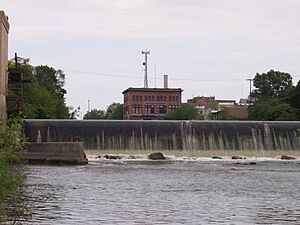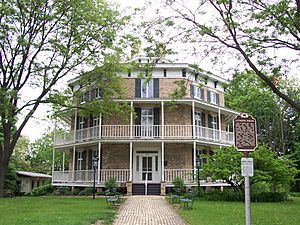Watertown, Wisconsin facts for kids
Quick facts for kids
Watertown, Wisconsin
|
|
|---|---|
|
City
|
|

Main Street in downtown Watertown
|
|

Location of Watertown in Dodge County, Wisconsin
|
|
| Country | |
| State | |
| Counties | Jefferson, Dodge |
| Government | |
| • Type | Mayor/Council |
| Area | |
| • Total | 12.46 sq mi (32.28 km2) |
| • Land | 12.06 sq mi (31.25 km2) |
| • Water | 0.40 sq mi (1.04 km2) |
| Elevation | 853 ft (260 m) |
| Population
(2020)
|
|
| • Total | 22,926 |
| • Density | 1,946.20/sq mi (751.43/km2) |
| Time zone | UTC-6 (Central (CST)) |
| • Summer (DST) | UTC-5 (CDT) |
| Area code(s) | 920 |
| FIPS code | 55-83975 |
| GNIS feature ID | 1576295 |
| Website | www.ci.watertown.wi.us |
Watertown is a city in Wisconsin, a state in the United States. It is located in both Dodge and Jefferson counties. Most of the people living in Watertown are in Jefferson County. A street called Division Street marks the line between the two counties. In 2020, about 22,926 people lived in Watertown. This city is the largest in the Watertown-Fort Atkinson area.
Contents
- Discovering Watertown's Past
- Watertown's Location and Weather
- People of Watertown
- Learning and Schools in Watertown
- Jobs and Businesses in Watertown
- Getting Around Watertown
- Health and Wellness in Watertown
- News and Entertainment in Watertown
- Famous Places in Watertown
- Notable People from Watertown
- Images for kids
- See also
Discovering Watertown's Past
How Watertown Began
Watertown was first settled in 1836 by a man named Timothy Johnson. He built a small cabin on the west side of the Rock River. Today, there is a park named after him in the city. The early settlers chose this area because of the powerful Rock River. The river drops about 20 feet (6 meters) over two miles, which was perfect for making power.
This water power was first used for sawmills. Later, it helped build two hydroelectric dams. These dams use the river's power to create electricity. One dam is downtown, and another is on the eastern edge of the city.
Early Settlers: Yankees and Germans
The first people to settle Watertown were mostly from New England. These "Yankee" settlers came from states like Connecticut and Massachusetts. They were descendants of the English Puritans who came to New England in the 1600s. They moved west to find new land after the Erie Canal was finished and the Black Hawk War ended.
When they arrived, the area was mostly thick forests and wild fields. These New Englanders built farms, roads, and government buildings. They also brought their values, like a strong belief in education and opposing slavery. They were mostly members of the Congregationalist Church. Watertown became a village in 1849 and a city in 1853.
In the 1850s, many immigrants from Germany came to Watertown. These German families brought their culture, including a love for classical music. The people already living in Watertown welcomed them. This made more German families want to move there. Both the Yankee and German communities worked well together. They both disliked slavery and enjoyed business and industry. They did not face many economic problems until the Great Depression much later.
Transportation and Growth in the 1800s
A canal was once planned to connect Milwaukee to Watertown. This canal would have linked the Great Lakes to the Mississippi River. However, the plan was stopped in 1848 because railroads became more popular.
In 1853, a special road called a plank road was built from Milwaukee to Watertown. These roads were made of wooden planks. Later, this route became a highway (Wisconsin Highway 16) and a railroad. A street in Milwaukee is still called "Watertown Plank Road."
Many German immigrants arrived in the late 1800s. Watertown is famous for having the first kindergarten in the United States. It was started in 1856 by Margarethe Schurz. Her husband was a well-known statesman, Carl Schurz. The building where this kindergarten began is now at the Octagon House Museum.
City's Railroad Challenges
Watertown's growth slowed down because of a problem with railroad bonds. The city had promised a lot of money (almost half a million dollars) to help build two railroads. They hoped these railroads would bring more growth. Bonds are like loans that people buy from the city.
However, in 1857, the two railroad companies went bankrupt. This meant they couldn't build the railroads or make money. The city couldn't pay back the bonds. The people who bought the bonds were not the original investors and were from out of town. The city even stopped its government for a while to avoid being forced to pay. This problem wasn't solved until 1889, when the highest court in the U.S. decided the city didn't have to pay most of it. A small amount was paid off in 1905.
Watertown's Location and Weather
Where is Watertown Located?
Watertown is in southeastern Wisconsin. It's about halfway between the cities of Madison and Milwaukee. The city covers about 12.46 square miles (32.28 square kilometers). Most of this area is land, with a small part being water.
The Rock River flows through Watertown in a curve, like a horseshoe. The city first grew inside this curve. Other small creeks also join the river in the city. The area has many drumlins, which are long hills shaped by ancient glaciers. These hills usually run from north to south.
Watertown's Climate and Seasons
Watertown has a climate with four distinct seasons. Summers are warm, and winters are cold with snow. The average high temperature in July is about 81.3°F (27.4°C). The average low temperature in January is about 10.5°F (-11.9°C).
The city gets a good amount of rain throughout the year, especially in summer. Snowfall is common in winter months, with January usually seeing the most snow.
People of Watertown
| Historical population | |||
|---|---|---|---|
| Census | Pop. | %± | |
| 1850 | 1,451 | — | |
| 1860 | 5,302 | 265.4% | |
| 1870 | 7,550 | 42.4% | |
| 1880 | 7,883 | 4.4% | |
| 1890 | 8,755 | 11.1% | |
| 1900 | 8,437 | −3.6% | |
| 1910 | 8,829 | 4.6% | |
| 1920 | 9,299 | 5.3% | |
| 1930 | 10,613 | 14.1% | |
| 1940 | 11,301 | 6.5% | |
| 1950 | 12,417 | 9.9% | |
| 1960 | 13,943 | 12.3% | |
| 1970 | 15,683 | 12.5% | |
| 1980 | 18,113 | 15.5% | |
| 1990 | 19,142 | 5.7% | |
| 2000 | 21,598 | 12.8% | |
| 2010 | 23,861 | 10.5% | |
| 2020 | 22,926 | −3.9% | |
| U.S. Decennial Census | |||
Who Lives in Watertown?
In 2020, the population of Watertown was 22,926 people. Most residents are White (87.9%). About 9.6% of the population identifies as Hispanic or Latino.
In 2010, there were 9,187 households in the city. About 33% of these households had children under 18 living there. The average age of people in Watertown was 35.7 years old. About 25.7% of residents were under 18, and 14.5% were 65 or older.
Learning and Schools in Watertown
Watertown has its own school district, called the Watertown Unified School District.
Public Schools
- High School: Watertown High School
- Middle School: Riverside Middle School
- Elementary Schools: Lincoln, Schurz, Douglas, and Webster
There is also a special public high school called Endeavor Charter School.
Private and Higher Education
Watertown has six parochial schools for elementary and middle school students. Four are Lutheran schools, and two are Catholic schools. Luther Preparatory School, which is connected to the Wisconsin Evangelical Lutheran Synod, is also in the city.
Maranatha Baptist University is located on the west side of Watertown. It also has a private high school called Maranatha Baptist Academy. A branch of the Madison Area Technical College is also on the west side of the city.
Jobs and Businesses in Watertown
Watertown has many important employers. These include the school district and the Watertown Regional Medical Center. There are also several companies that work in light industry, food processing, metals, and electronics. Some companies focus on regional distribution.
Rail & Transload, Inc.
Rail & Transload, Inc. is a company in Watertown that helps move goods. It's a transloading facility, meaning it transfers goods from one type of transportation to another, like from trains to trucks. It has about 1,100 feet of train tracks. The facility can hold up to 125 freight cars, mostly hoppers and tank cars.
Getting Around Watertown
Main Roads
Airport Services
The Watertown Municipal Airport (KRYV) serves Watertown and nearby towns. It's used for smaller planes and private flights.
Train Travel
Amtrak passenger trains, like the Empire Builder and Borealis, go through Watertown but do not stop there. The closest Amtrak station is in Columbus, Wisconsin. Freight trains are operated by the Canadian Pacific Railway (CP), the Union Pacific Railroad (UP), and the Wisconsin and Southern Railroad (WSOR). There are plans to possibly add a train stop in Watertown for some Hiawatha trains in the future.
Local Transportation
Watertown has a "Watertown Transit" service. This service uses taxis and small buses to provide shared rides to different stops requested by people.
Health and Wellness in Watertown
Watertown Regional Medical Center is a hospital with 95 beds. It has a level III trauma center, which means it can handle serious injuries. There are about 35.4 primary care doctors for every 100,000 people in the area.
Watertown is considered a "mental health Health Professional Shortage Area." This means there aren't enough mental health professionals in the city. By 2035, it's thought that Watertown might have a big shortage of primary care doctors.
News and Entertainment in Watertown
Local Newspaper
The local newspaper is the Watertown Daily Times. It started on November 23, 1895. Today, about 25,000 people read the newspaper.
Radio Stations
The radio station WMDX (AM 1580) used to be in Watertown. Now, its main office is in Madison, and it broadcasts news and talk shows. WJJO (94.1 FM) also started in Watertown but is now in Madison, playing active rock music. Watertown can still receive radio stations from Madison, Milwaukee, and Janesville.
Local TV Channel
Watertown has a local TV channel run by the city government. This channel shows church services, special programs, sports, and community events. Watertown is part of the Milwaukee television market, but you can also watch stations from Madison.
Famous Places in Watertown
- Beals and Torrey Shoe Co. Building
- Chicago and North Western Depot
- First Kindergarten
- August and Eliza Fuermann Jr. House
- Octagon House
Notable People from Watertown
Many interesting people have come from Watertown, including:
- Daniel Brandenstein, a NASA astronaut who flew on four space shuttle missions.
- Mary Lasker, a health activist who received the Presidential Medal of Freedom.
- Fred Merkle, a famous baseball player nicknamed "Bonehead."
- Ben Peterson, an Olympic gold and silver medalist in wrestling.
- Carl Schurz, who was a U.S. Secretary of the Interior.
- Margarethe Schurz, who started the first kindergarten in the U.S.
- Meinhardt Raabe, an actor.
Images for kids
See also
 In Spanish: Watertown (Wisconsin) para niños
In Spanish: Watertown (Wisconsin) para niños




